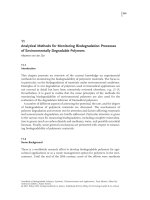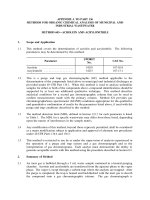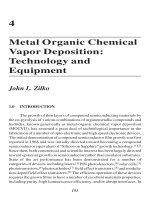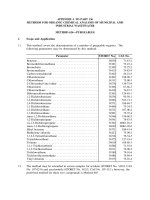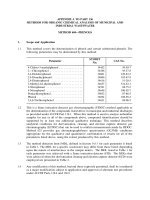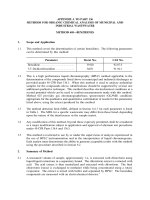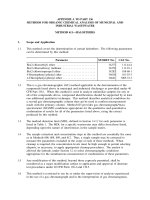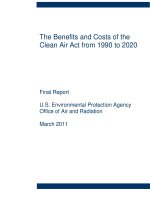APPENDIX A TO PART 136 METHODS FOR ORGANIC CHEMICAL ANALYSIS OF MUNICIPAL AND INDUSTRIAL WASTEWATER: METHOD 611—HALOETHERS potx
Bạn đang xem bản rút gọn của tài liệu. Xem và tải ngay bản đầy đủ của tài liệu tại đây (126.21 KB, 19 trang )
APPENDIX A TO PART 136
METHODS FOR ORGANIC CHEMICAL ANALYSIS OF MUNICIPAL AND
INDUSTRIAL WASTEWATER
METHOD 611—HALOETHERS
1. Scope and Application
1.1 This method covers the determination of certain haloethers. The following parameters
can be determined by this method:
Parameter STORET No. CAS No.
Bis(2-chloroethyl) ether 34273 111-44-4
Bis(2-chloroethoxy) methane 34278 111-91-1
Bis(2-chloroisopropyl) ether 34283 108-60-1
4-Bromophenyl phenyl ether 34636 101-55-3
4-Chlorophenyl phenyl ether 34641 7005-72-3
1.2 This is a gas chromatographic (GC) method applicable to the determination of the
compounds listed above in municipal and industrial discharges as provided under 40
CFR Part 136.1. When this method is used to analyze unfamiliar samples for any or
all of the compounds above, compound identifications should be supported by at least
one additional qualitative technique. This method describes analytical conditions for
a second gas chromatographic column that can be used to confirm measurements
made with the primary column. Method 625 provides gas chromatograph/mass
spectrometer (GC/MS) conditions appropriate for the qualitative and quantitative
confirmation of results for all of the parameters listed above, using the extract
produced by this method.
1.3 The method detection limit (MDL, defined in Section 14.1) for each parameter is
1
listed in Table 1. The MDL for a specific wastewater may differ from those listed,
depending upon the nature of interferences in the sample matrix.
1.4 The sample extraction and concentration steps in this method are essentially the same
as in Methods 606, 608, 609, and 612. Thus, a single sample may be extracted to
measure the parameters included in the scope of each of these methods. When
cleanup is required, the concentration levels must be high enough to permit selecting
aliquots, as necessary, to apply appropriate cleanup procedures. The analyst is
allowed the latitude, under Section 12, to select chromatographic conditions
appropriate for the simultaneous measurement of combinations of these parameters.
1.5 Any modification of this method, beyond those expressly permitted, shall be
considered as a major modification subject to application and approval of alternate
test procedures under 40 CFR Parts 136.4 and 136.5.
1.6 This method is restricted to use by or under the supervision of analysts experienced
in the use of a gas chromatograph and in the interpretation of gas chromatograms.
Each analyst must demonstrate the ability to generate acceptable results with this
method using the procedure described in Section 8.2.
2. Summary of Method
2.1 A measured volume of sample, approximately 1 L, is extracted with methylene
chloride using a separatory funnel. The methylene chloride extract is dried and
exchanged to hexane during concentration to a volume of 10 mL or less. The extract
is separated by gas chromatography and the parameters are then measured with a
halide specific detector.
2
2.2 The method provides a Florisil column cleanup procedure to aid in the elimination of
interferences that may be encountered.
3. Interferences
3.1 Method interferences may be caused by contaminants in solvents, reagents, glassware,
and other sample processing hardware that lead to discrete artifacts and/or elevated
baselines in gas chromatograms. All of these materials must be routinely
demonstrated to be free from interferences under the conditions of the analysis by
running laboratory reagent blanks as described in Section 8.1.3.
3.1.1 Glassware must be scrupulously cleaned. Clean all glassware as soon as
3
possible after use by rinsing with the last solvent used in it. Solvent rinsing
should be followed be detergent washing with hot water, and rinses with tap
water and distilled water. The glassware should then be drained dry, and
heated in a muffle furnace at 400°C for 15-30 minutes. Some thermally stable
materials, such as PCBs, may not be eliminated by this treatment. Solvent
rinses with acetone and pesticide quality hexane may be substituted for the
muffle furnace heating. Thorough rinsing with such solvents usually eliminates
PCB interference. Volumetric ware should not be heated in a muffle furnace.
After drying and cooling, glassware should be sealed and stored in a clean
environment to prevent any accumulation of dust or other contaminants. Store
inverted or capped with aluminum foil.
3.1.2 The use of high purity reagents and solvents helps to minimize interference
problems. Purification of solvents by distillation in all-glass systems may be
required.
3.2 Matrix interferences may be caused by contaminants that are co-extracted from the
sample. The extent of matrix interferences will vary considerably from source to
source, depending upon the nature and diversity of the industrial complex or
municipality being sampled. The cleanup procedure in Section 11 can be used to
overcome many of these interferences, but unique samples may require additional
cleanup approaches to achieve the MDL listed in Table 1.
3.3 Dichlorobenzenes are known to coelute with haloethers under some gas
chromatographic conditions. If these materials are present together in a sample, it
may be necessary to analyze the extract with two different column packings to
completely resolve all of the compounds.
4. Safety
4.1 The toxicity or carcinogenicity of each reagent used in this method has not been
precisely defined; however, each chemical compound should be treated as a potential
health hazard. From this viewpoint, exposure to these chemicals must be reduced to
the lowest possible level by whatever means available. The laboratory is responsible
for maintaining a current awareness file of OSHA regulations regarding the safe
handling of the chemicals specified in this method. A reference file of material data
handling sheets should also be made available to all personnel involved in the
chemical analysis. Additional references to laboratory safety are available and have
been identified for the information of the analyst.
4-6
5. Apparatus and Materials
5.1 Sampling equipment, for discrete or composite sampling.
5.1.1 Grab sample bottle—1 L or 1 qt, amber glass, fitted with a screw cap lined
with Teflon. Foil may be substituted for Teflon if the sample is not corrosive.
If amber bottles are not available, protect samples from light. The bottle and
cap liner must be washed, rinsed with acetone or methylene chloride, and
dried before use to minimize contamination.
5.1.2 Automatic sampler (optional)—The sampler must incorporate glass sample
containers for the collection of a minimum of 250 mL of sample. Sample
containers must be kept refrigerated at 4°C and protected from light during
compositing. If the sampler uses a peristaltic pump, a minimum length of
compressible silicone rubber tubing may be used. Before use, however, the
compressible tubing should be thoroughly rinsed with methanol, followed by
repeated rinsings with distilled water to minimize the potential for
contamination of the sample. An integrating flow meter is required to collect
flow proportional composites.
5.2 Glassware (All specifications are suggested. Catalog numbers are included for
illustration only.)
5.2.1 Separatory funnel—2 L, with Teflon stopcock.
5.2.2 Drying column—Chromatographic column, approximately 400 mm long x 19
mm ID, with coarse frit filter disc.
5.2.3 Chromatographic column—400 mm long x 19 mm ID, with Teflon stopcock
and coarse frit filter disc at bottom (Kontes K-420540-0224 or equivalent).
5.2.4 Concentrator tube, Kuderna-Danish—10 mL, graduated (Kontes K-570050-1025
or equivalent). Calibration must be checked at the volumes employed in the
test. Ground glass stopper is used to prevent evaporation of extracts.
5.2.5 Evaporative flask, Kuderna-Danish—500 mL (Kontes K-570001-0500 or
equivalent). Attach to concentrator tube with springs.
5.2.6 Snyder column, Kuderna-Danish—Three-ball macro (Kontes K-503000-0121 or
equivalent).
5.2.7 Vials—10-15 mL, amber glass, with Teflon-lined screw cap.
5.3 Boiling chips—Approximately 10/40 mesh. Heat to 400°C for 30 minutes or Soxhlet
extract with methylene chloride.
5.4 Water bath—Heated, with concentric ring cover, capable of temperature control
(±2°C). The bath should be used in a hood.
5.5 Balance—Analytical, capable of accurately weighing 0.0001 g.
5.6 Gas chromatograph—An analytical system complete with temperature programmable
gas chromatograph suitable for on-column injection and all required accessories
including syringes, analytical columns, gases, detector, and strip-chart recorder. A
data system is recommended for measuring peak areas.
5.6.1 Column 1—1.8 m long x 2 mm ID glass, packed with 3% SP-1000 on
Supelcoport (100/120 mesh) or equivalent. This column was used to develop
the method performance statements in Section 14. Guidelines for the use of
alternate column packings are provided in Section 12.1.
5.6.2 Column 2—1.8 m long x 2 mm ID glass, packed with 2,6-diphenylene oxide
polymer (60/80 mesh), Tenax, or equivalent.
5.6.3 Detector—Halide specific detector: electrolytic conductivity or
microcoulometric. These detectors have proven effective in the analysis of
wastewaters for the parameters listed in the scope (Section 1.1). The Hall
conductivity detector was used to develop the method performance statements
in Section 14. Guidelines for the use of alternate detectors are provided in
Section 12.1. Although less selective, an electron capture detector is an
acceptable alternative.
6. Reagents
6.1 Reagent water—Reagent water is defined as a water in which an interferent is not
observed at the MDL of the parameters of interest.
6.2 Sodium thiosulfate—(ACS) Granular.
6.3 Acetone, hexane, methanol, methylene chloride, petroleum ether (boiling range
30-60°C)—Pesticide quality or equivalent.
6.4 Sodium sulfate—(ACS) Granular, anhydrous. Purify by heating at 400°C for four
hours in a shallow tray.
6.5 Florisil—PR Grade (60/100 mesh). Purchase activated at 1250°F and store in the dark
in glass containers with ground glass stoppers or foil-lined screw caps. Before use,
activate each batch at least 16 hours at 130°C in a foil-covered glass container and
allow to cool.
6.6 Ethyl ether—Nanograde, redistilled in glass if necessary.
6.6.1 Ethyl ether must be shown to be free of peroxides before it is used as indicated
by EM Laboratories Quant test strips. (Available from Scientific Products Co.,
Cat. No. P1126-8, and other suppliers.)
6.6.2 Procedures recommended for removal of peroxides are provided with the test
strips. After cleanup, 20 mL of ethyl alcohol preservative must be added to
each liter of ether.
6.7 Stock standard solutions (1.00 µg/µL)—Stock standard solutions can be prepared from
pure standard materials or purchased as certified solutions.
6.7.1 Prepare stock standard solutions by accurately weighing about 0.0100 g of
pure material. Dissolve the material in acetone and dilute to volume in a 10
mL volumetric flask. Larger volumes can be used at the convenience of the
analyst. When compound purity is assayed to be 96% or greater, the weight
can be used without correction to calculate the concentration of the stock
standard. Commercially prepared stock standards can be used at any
concentration if they are certified by the manufacturer or by an independent
source.
6.7.2 Transfer the stock standard solutions into Teflon-sealed screw-cap bottles.
Store at 4°C and protect from light. Stock standard solutions should be
checked frequently for signs of degradation or evaporation, especially just
prior to preparing calibration standards from them.
6.7.3 Stock standard solutions must be replaced after six months, or sooner if
comparison with check standards indicates a problem.
6.8 Quality control check sample concentrate—See Section 8.2.1.
7. Calibration
7.1 Establish gas chromatographic operating conditions equivalent to those given in Table
1. The gas chromatographic system can be calibrated using the external standard
technique (Section 7.2) or the internal standard technique (Section 7.3).
7.2 External standard calibration procedure
7.2.1 Prepare calibration standards at a minimum of three concentration levels for
each parameter of interest by adding volumes of one or more stock standards
to a volumetric flask and diluting to volume with hexane. One of the external
standards should be at a concentration near, but above, the MDL (Table 1) and
the other concentrations should correspond to the expected range of
concentrations found in real samples or should define the working range of the
detector.
This equation corrects an error made in the original method publication (49 FR 43234,
October 26, 1984). This correction will be formalized through a rulemaking in FY97.
7.2.2 Using injections of 2-5 µL, analyze each calibration standard according to
Section 12 and tabulate peak height or area responses against the mass
injected. The results can be used to prepare a calibration curve for each
compound. Alternatively, if the ratio of response to amount injected
(calibration factor) is a constant over the working range (<10% relative
standard deviation, RSD), linearity through the origin can be assumed and the
average ratio or calibration factor can be used in place of a calibration curve.
7.3 Internal standard calibration procedure—To use this approach, the analyst must select
one or more internal standards that are similar in analytical behavior to the
compounds of interest. The analyst must further demonstrate that the measurement
of the internal standard is not affected by method or matrix interferences. Because of
these limitations, no internal standard can be suggested that is applicable to all
samples.
7.3.1 Prepare calibration standards at a minimum of three concentration levels for
each parameter of interest by adding volumes of one or more stock standards
to a volumetric flask. To each calibration standard, add a known constant
amount of one or more internal standards, and dilute to volume with hexane.
One of the standards should be at a concentration near, but above, the MDL
and the other concentrations should correspond to the expected range of
concentrations found in real samples or should define the working range of the
detector.
7.3.2 Using injections of 2-5 µL, analyze each calibration standard according to
Section 12 and tabulate peak height or area responses against concentration for
each compound and internal standard. Calculate response factors (RF) for
each compound using Equation 1.
Equation 1
where:
A = Response for the parameter to be measured.
s
A = Response for the internal standard.
is
C = Concentration of the internal standard (µg/L).
is
C = Concentration of the parameter to be measured (µg/L).
s
If the RF value over the working range is a constant (<10% RSD), the RF can
be assumed to be invariant and the average RF can be used for calculations.
Alternatively, the results can be used to plot a calibration curve of response
ratios, A /A , vs. concentration ratios C /C .
sis sis
*
7.4 The working calibration curve, calibration factor, or RF must be verified on each
working day by the measurement of one or more calibration standards. If the
response for any parameter varies from the predicted response by more than ±15%, a
new calibration curve must be prepared for that compound.
7.5 The cleanup procedure in Section 11 utilizes Florisil column chromatography. Florisil
from different batches or sources may vary in adsorptive capacity. To standardize the
amount of Florisil which is used, the use of lauric acid value is suggested. The
7
referenced procedure determines the adsorption from hexane solution of lauric acid
(mg) per g of Florisil. The amount of Florisil to be used for each column is calculated
by dividing 110 by this ratio and multiplying by 20 g.
7.6 Before using any cleanup procedure, the analyst must process a series of calibration
standards through the procedure to validate elution patterns and the absence of
interferences from the reagents.
8. Quality Control
8.1 Each laboratory that uses this method is required to operate a formal quality control
program. The minimum requirements of this program consist of an initial
demonstration of laboratory capability and an ongoing analysis of spiked samples to
evaluate and document data quality. The laboratory must maintain records to
document the quality of data that is generated. Ongoing data quality checks are
compared with established performance criteria to determine if the results of analyses
meet the performance characteristics of the method. When results of sample spikes
indicate atypical method performance, a quality control check standard must be
analyzed to confirm that the measurements were performed in an in-control mode of
operation.
8.1.1 The analyst must make an initial, one-time, demonstration of the ability to
generate acceptable accuracy and precision with this method. This ability is
established as described in Section 8.2.
8.1.2 In recognition of advances that are occurring in chromatography, the analyst is
permitted certain options (detailed in Sections 10.4, 11.1, and 12.1) to improve
the separations or lower the cost of measurements. Each time such a
modification is made to the method, the analyst is required to repeat the
procedure in Section 8.2.
8.1.3 Before processing any samples, the analyst must analyze a reagent water blank
to demonstrate that interferences from the analytical system and glassware are
under control. Each time a set of samples is extracted or reagents are changed,
a reagent water blank must be processed as a safeguard against laboratory
contamination.
8.1.4 The laboratory must, on an ongoing basis, spike and analyze a minimum of
10% of all samples to monitor and evaluate laboratory data quality. This
procedure is described in Section 8.3.
8.1.5 The laboratory must, on an ongoing basis, demonstrate through the analyses of
quality control check standards that the operation of the measurement system
is in control. This procedure is described in Section 8.4. The frequency of the
check standard analyses is equivalent to 10% of all samples analyzed but may
be reduced if spike recoveries from samples (Section 8.3) meet all specified
quality control criteria.
8.1.6 The laboratory must maintain performance records to document the quality of
data that is generated. This procedure is described in Section 8.5.
8.2 To establish the ability to generate acceptable accuracy and precision, the analyst must
perform the following operations.
8.2.1 A quality control (QC) check sample concentrate is required containing each
parameter of interest at a concentration of 100 µg/mL in acetone. The QC
check sample concentrate must be obtained from the U.S. Environmental
Protection Agency, Environmental Monitoring and Support Laboratory in
Cincinnati, Ohio, if available. If not available from that source, the QC check
sample concentrate must be obtained from another external source. If not
available from either source above, the QC check sample concentrate must be
prepared by the laboratory using stock standards prepared independently from
those used for calibration.
8.2.2 Using a pipet, prepare QC check samples at a concentration of 100 µg/L by
adding 1.00 mL of QC check sample concentrate to each of four 1 L aliquots of
reagent water.
8.2.3 Analyze the well-mixed QC check samples according to the method beginning
in Section 10.
8.2.4 Calculate the average recovery ( ) in µg/L, and the standard deviation of the
recovery (s) in µg/L, for each parameter using the four results.
8.2.5 For each parameter compare s and with the corresponding acceptance
criteria for precision and accuracy, respectively, found in Table 2. If s and
for all parameters of interest meet the acceptance criteria, the system
performance is acceptable and analysis of actual samples can begin. If any
individual s exceeds the precision limit or any individual falls outside the
range for accuracy, the system performance is unacceptable for that parameter.
Locate and correct the source of the problem and repeat the test for all
parameters of interest beginning with Section 8.2.2.
8.3 The laboratory must, on an ongoing basis, spike at least 10% of the samples from each
sample site being monitored to assess accuracy. For laboratories analyzing one to ten
samples per month, at least one spiked sample per month is required.
8.3.1 The concentration of the spike in the sample should be determined as follows:
8.3.1.1 If, as in compliance monitoring, the concentration of a specific
parameter in the sample is being checked against a regulatory
concentration limit, the spike should be at that limit or one to five times
higher than the background concentration determined in Section 8.3.2,
whichever concentration would be larger.
8.3.1.2 If the concentration of a specific parameter in the sample is not being
checked against a limit specific to that parameter, the spike should be
at 100 µg/L or one to five times higher than the background
concentration determined in Section 8.3.2, whichever concentration
would be larger.
8.3.1.3 If it is impractical to determine background levels before spiking (e.g.,
maximum holding times will be exceeded), the spike concentration
should be (1) the regulatory concentration limit, if any; or, if none (2)
the larger of either five times higher than the expected background
concentration or 100 µg/L.
8.3.2 Analyze one sample aliquot to determine the background concentration (B) of
each parameter. If necessary, prepare a new QC check sample concentrate
(Section 8.2.1) appropriate for the background concentrations in the sample.
Spike a second sample aliquot with 1.0 mL of the QC check sample concentrate
and analyze it to determine the concentration after spiking (A) of each
parameter. Calculate each percent recovery (P) as 100 (A-B)%/T, where T is
the known true value of the spike.
8.3.3 Compare the percent recovery (P) for each parameter with the corresponding
QC acceptance criteria found in Table 2. These acceptance criteria were
calculated to include an allowance for error in measurement of both the
background and spike concentrations, assuming a spike to background ratio of
5:1. This error will be accounted for to the extent that the analyst's spike to
background ratio approaches 5:1. If spiking was performed at a concentration
8
lower than 100 µg/L, the analyst must use either the QC acceptance criteria in
Table 2, or optional QC acceptance criteria calculated for the specific spike
concentration. To calculate optional acceptance criteria for the recovery of a
parameter: (1) Calculate accuracy (X′) using the equation in Table 3,
substituting the spike concentration (T) for C; (2) calculate overall precision (S′)
using the equation in Table 3, substituting X′ for ; (3) calculate the range for
recovery at the spike concentration as (100 X′/T) ±2.44 (100 S′/T)%.
8
8.3.4 If any individual P falls outside the designated range for recovery, that
parameter has failed the acceptance criteria. A check standard containing each
parameter that failed the criteria must be analyzed as described in Section 8.4.
8.4 If any parameter fails the acceptance criteria for recovery in Section 8.3, a QC check
standard containing each parameter that failed must be prepared and analyzed.
NOTE: The frequency for the required analysis of a QC check standard will
depend upon the number of parameters being simultaneously tested,
the complexity of the sample matrix, and the performance of the
laboratory.
8.4.1 Prepare the QC check standard by adding 1.0 m/L of QC check sample
concentrate (Section 8.2.1 or 8.3.2) to 1 L of reagent water. The QC check
standard needs only to contain the parameters that failed criteria in the test in
Section 8.3.
8.4.2 Analyze the QC check standard to determine the concentration measured (A)
of each parameter. Calculate each percent recovery (P ) as 100 (A/T)%, where
s
T is the true value of the standard concentration.
8.4.3 Compare the percent recovery (P ) for each parameter with the corresponding
s
QC acceptance criteria found in Table 2. Only parameters that failed the test
in Section 8.3 need to be compared with these criteria. If the recovery of any
such parameter falls outside the designated range, the laboratory performance
for that parameter is judged to be out of control, and the problem must be
immediately identified and corrected. The analytical result for that parameter
in the unspiked sample is suspect and may not be reported for regulatory
compliance purposes.
8.5 As part of the QC program for the laboratory, method accuracy for wastewater
samples must be assessed and records must be maintained. After the analysis of five
spiked wastewater samples as in Section 8.3, calculate the average percent recovery
( ) and the standard deviation of the percent recovery (s ). Express the accuracy
p
assessment as a percent recovery interval from -2s to +2s . If =90% and s =10%,
pp p
for example, the accuracy interval is expressed as 70-110%. Update the accuracy
assessment for each parameter on a regular basis (e.g., after each 5-10 new accuracy
measurements).
8.6 It is recommended that the laboratory adopt additional quality assurance practices for
use with this method. The specific practices that are most productive depend upon
the needs of the laboratory and the nature of the samples. Field duplicates may be
analyzed to assess the precision of the environmental measurements. When doubt
exists over the identification of a peak on the chromatogram, confirmatory techniques
such as gas chromatography with a dissimilar column, specific element detector, or
mass spectrometer must be used. Whenever possible, the laboratory should analyze
standard reference materials and participate in relevant performance evaluation
studies.
9. Sample Collection, Preservation, and Handling
9.1 Grab samples must be collected in glass containers. Conventional sampling practices
9
should be followed, except that the bottle must not be prerinsed with sample before
collection. Composite samples should be collected in refrigerated glass containers in
accordance with the requirements of the program. Automatic sampling equipment
must be as free as possible of Tygon tubing and other potential sources of
contamination.
9.2 All samples must be iced or refrigerated at 4°C from the time of collection until
extraction. Fill the sample bottles and, if residual chlorine is present, add 80 mg of
sodium thiosulfate per liter of sample and mix well. EPA Methods 330.4 and 330.5
may be used for measurement of residual chlorine. Field test kits are available for
10
this purpose.
9.3 All samples must be extracted within seven days of collection and completely
analyzed within 40 days of extraction.
2
10. Sample Extraction
10.1 Mark the water meniscus on the side of the sample bottle for later determination of
sample volume. Pour the entire sample into a 2 L separatory funnel.
10.2 Add 60 mL methylene chloride to the sample bottle, seal, and shake 30 seconds to
rinse the inner surface. Transfer the solvent to the separatory funnel and extract the
sample by shaking the funnel for two minutes with periodic venting to release excess
pressure. Allow the organic layer to separate from the water phase for a minimum of
10 minutes. If the emulsion interface between layers is more than one-third the
volume of the solvent layer, the analyst must employ mechanical techniques to
complete the phase separation. The optimum technique depends upon the sample, but
may include stirring, filtration of the emulsion through glass wool, centrifugation, or
other physical methods. Collect the methylene chloride extract in a 250 mL
Erlenmeyer flask.
10.3 Add a second 60 mL volume of methylene chloride to the sample bottle and repeat
the extraction procedure a second time, combining the extracts in the Erlenmeyer
flask. Perform a third extraction in the same manner.
10.4 Assemble a Kuderna-Danish (K-D) concentrator by attaching a 10 mL concentrator
tube to a 500 mL evaporative flask. Other concentration devices or techniques may be
used in place of the K-D concentrator if the requirements of Section 8.2 are met.
10.5 Pour the combined extract through a solvent-rinsed drying column containing about
10 cm of anhydrous sodium sulfate, and collect the extract in the K-D concentrator.
Rinse the Erlenmeyer flask and column with 20-30 mL of methylene chloride to
complete the quantitative transfer.
10.6 Add one or two clean boiling chips to the evaporative flask and attach a three-ball
Snyder column. Prewet the Snyder column by adding about 1 mL of methylene
chloride to the top. Place the K-D apparatus on a hot water bath (60-65°C) so that the
concentrator tube is partially immersed in the hot water, and the entire lower
rounded surface of the flask is bathed with hot vapor. Adjust the vertical position of
the apparatus and the water temperature as required to complete the concentration in
15-20 minutes. At the proper rate of distillation the balls of the column will actively
chatter but the chambers will not flood with condensed solvent. When the apparent
volume of liquid reaches 1 mL, remove the K-D apparatus and allow it to drain and
cool for at least 10 minutes.
NOTE: Some of the haloethers are very volatile and significant losses will occur
in concentration steps if care is not exercised. It is important to
maintain a constant gentle evaporation rate and not to allow the liquid
volume to fall below 1-2 mL before removing the K-D apparatus from
the hot water bath.
10.7 Momentarily remove the Snyder column, add 50 mL of hexane and a new boiling
chip, and reattach the Snyder column. Raise the temperature of the water bath to 85-
90°C. Concentrate the extract as in Section 10.6, except use hexane to prewet the
column. The elapsed time of concentration should be 5-10 minutes.
10.8 Remove the Snyder column and rinse the flask and its lower joint into the
concentrator tube with 1-2 mL of hexane. A 5 mL syringe is recommended for this
operation. Stopper the concentrator tube and store refrigerated if further processing
will not be performed immediately. If the extract will be stored longer than two days,
it should be transferred to a Teflon-sealed screw-cap vial. If the sample extract
requires no further cleanup, proceed with gas chromatographic analysis (Section 12).
If the sample requires further cleanup, proceed to Section 11.
10.9 Determine the original sample volume by refilling the sample bottle to the mark and
transferring the liquid to a 1000 mL graduated cylinder. Record the sample volume to
the nearest 5 mL.
11. Cleanup and Separation
11.1 Cleanup procedures may not be necessary for a relatively clean sample matrix. If
particular circumstances demand the use of a cleanup procedure, the analyst may use
the procedure below or any other appropriate procedure. However, the analyst first
must demonstrate that the requirements of Section 8.2 can be met using the method as
revised to incorporate the cleanup procedure.
11.2 Florisil column cleanup for haloethers
11.2.1 Adjust the sample extract volume to 10 mL.
11.2.2 Place a weight of Florisil (nominally 20 g) predetermined by calibration
(Section 7.5), into a chromatographic column. Tap the column to settle the
Florisil and add 1-2 cm of anhydrous sodium sulfate to the top.
11.2.3 Preelute the column with 50-60 mL of petroleum ether. Discard the eluate and
just prior to exposure of the sodium sulfate layer to the air, quantitatively
transfer the sample extract onto the column by decantation and subsequent
petroleum ether washings. Discard the eluate. Just prior to exposure of the
sodium sulfate layer to the air, begin eluting the column with 300 mL of ethyl
ether/petroleum ether (6+94) (V/V). Adjust the elution rate to approximately
5 mL/min. and collect the eluate in a 500 mL K-D flask equipped with a 10
mL concentrator tube. This fraction should contain all of the haloethers.
11.2.4 Concentrate the fraction as in Section 10.6, except use hexane to prewet the
column. When the apparatus is cool, remove the Snyder column and rinse the
flask and its lower joint into the concentrator tube with hexane. Adjust the
volume of the cleaned up extract to 10 mL with hexane and analyze by gas
chromatography (Section 12).
12. Gas Chromatography
12.1 Table 1 summarizes the recommended operating conditions for the gas
chromatograph. Included in this table are retention times and MDL that can be
achieved under these conditions. Examples of the separations achieved by Columns 1
and 2 are shown in Figures 1 and 2, respectively. Other packed or capillary
(open-tubular) columns, chromatographic conditions, or detectors may be used if the
requirements of Section 8.2 are met.
12.2 Calibrate the system daily as described in Section 7.
12.3 If the internal standard calibration procedure is being used, the internal standard
must be added to the sample extract and mixed thoroughly immediately before
injection into the gas chromatrograph.
12.4 Inject 2-5 µL of the sample extract or standard into the gas chromatograph using the
solvent-flush technique. Smaller (1.0 µL) volumes may be injected if automatic
11
devices are employed. Record the volume injected to the nearest 0.05 µL, the total
extract volume, and the resulting peak size in area or peak height units.
12.5 Identify the parameters in the sample by comparing the retention times of the peaks
in the sample chromatogram with those of the peaks in standard chromatograms.
The width of the retention time window used to make identifications should be based
upon measurements of actual retention time variations of standards over the course of
a day. Three times the standard deviation of a retention time for a compound can be
used to calculate a suggested window size; however, the experience of the analyst
should weight heavily in the interpretation of chromatograms.
12.6 If the response for a peak exceeds the working range of the system, dilute the extract
and reanalyze.
12.7 If the measurement of the peak response is prevented by the presence of interferences,
further cleanup is required.
13. Calculations
13.1 Determine the concentration of individual compounds in the sample.
13.1.1 If the external standard calibration procedure is used, calculate the amount of
material injected from the peak response using the calibration curve or
calibration factor determined in Section 7.2.2. The concentration in the sample
can be calculated from Equation 2.
Equation 2
where:
A = Amount of material injected (ng).
V = Volume of extract injected (µL).
i
V = Volume of total extract (µL).
t
V = Volume of water extracted (mL).
s
13.1.2 If the internal standard calibration procedure is used, calculate the
concentration in the sample using the response factor (RF) determined in
Section 7.3.2 and Equation 3.
Equation 3
where:
A = Response for the parameter to be measured.
s
A = Response for the internal standard.
is
I = Amount of internal standard added to each extract (µg).
s
V = Volume of water extracted (L).
o
13.2 Report results in µg/L without correction for recovery data. All QC data obtained
should be reported with the sample results.
14. Method Performance
14.1 The method detection limit (MDL) is defined as the minimum concentration of a
substance that can be measured and reported with 99% confidence that the value is
above zero. The MDL concentrations listed in Table 1 were obtained using reagent
1
water. Similar results were achieved using representative wastewaters. The MDL
12
actually achieved in a given analysis will vary depending on instrument sensitivity
and matrix effects.
14.2 This method has been tested for linearity of spike recovery from reagent water and
has been demonstrated to be applicable over the concentration range from 4 x MDL to
1000 x MDL.
12
14.3 This method was tested by 20 laboratories using reagent water, drinking water,
surface water, and three industrial wastewaters spiked at six concentrations over the
range 1.0-626 µ/L. Single operator precision, overall precision, and method accuracy
12
were found to be directly related to the concentration of the parameter and essentially
independent of the sample matrix. Linear equations to describe these relationships
are presented in Table 3.
References
1. 40 CFR Part 136, Appendix B.
2. “Determination of Haloethers in Industrial and Municipal Wastewaters,” EPA
600/4-81-062, National Technical Information Service, PB81-232290, Springfield,
Virginia 22161, July 1981.
3. ASTM Annual Book of Standards, Part 31, D3694-78. “Standard Practices for
Preparation of Sample Containers and for Preservation of Organic Constitutents,”
American Society for Testing and Materials, Philadelphia.
4. “Carcinogens-Working Carcinogens,” Department of Health, Education, and Welfare,
Public Health Services, Center for Disease Control, National Institute for Occupational
Safety and Health, Publication No. 77-206, August 1977.
5. “OSHA Safety and Health Standards, General Industry,” (29 CFR part 1910),
Occupational Safety and Health Administration, OSHA 2206 (Revised, January 1976).
6. “Safety in Academic Chemistry Laboratories,” American Chemical Society Publication,
Committee on Chemical Safety, 3rd Edition, 1979.
7. Mills., P.A. “Variation of Florisil Activity: Simple Method for Measuring Absorbent
Capacity and Its Use in Standardizing Florisil Columns,” Journal of the Association of
Official Analytical Chemists, 51, 29 (1968).
8. Provost, L.P. and Elder, R.S. “Interpretation of Percent Recovery Data,” American
Laboratory, 15, 58-63 (1983). (The value 2.44 used in the equation in Section 8.3.3 is
two times the value 1.22 derived in this report.)
9. ASTM Annual Book of Standards, Part 31, D3370-76. “Standard Practices for
Sampling Water,” American Society for Testing and Materials, Philadelphia.
10. “Methods 330.4 (Titrimetric, DPD-FAS) and 330.5 (Spectrophotometric, DPD) for
Chlorine, Total Residual,” Methods for Chemical Analysis of Water and Wastes,
EPA-600/4-79-020, U.S. Environmental Protection Agency, Environmental Monitoring
and Support Laboratory, Cincinnati, Ohio 45268, March 1979.
11. Burke, J.A. “Gas Chromatography for Pesticide Residue Analysis; Some Practical
Aspects,” Journal of the Association of Official Analytical Chemists, 48, 1037 (1965).
12. “EPA Method Study 21, Method 611, Haloethers,” EPA 600/4-84-052, National
Technical Information Service, PB84-205939, Springfield, Virginia 22161, June 1984.
Table 1—Chromatographic Conditions and Methods Detection Limits
Parameters detection
Retention Time
(min)
Method
limit (µ/L)
Column 1 Column 2
Bis(2-chloroisopropyl)ether 8.4 9.7 0.8
Bis(2-chloroethyl)ether 9.3 9.1 0.3
Bis(2-chloroethoxy)methane 13.1 10.0 0.5
4-Chlorophenyl ether 19.4 15.0 3.9
4-Bromophenyl phenyl ether 21.2 16.2 2.3
Column 1 conditions: Supelcoport (100/120 mesh) coated with 3% SP-1000 packed in a 1.8
m long x 2 mm ID glass column with helium carrier gas at 40 mL/min. flow rate. Column
temperature held at 60°C for two minutes after injection then programmed at 8°C/min. to
230°C and held for four minutes. Under these conditions the retention time for Aldrin is
22.6 minutes.
Column 2 conditions: Tenax-GC (60/80 mesh) packed in a 1.8 m long x 2mm ID glass
column with helium carrier gas at 40 mL/min. flow rate. Column temperature held at 150°C
for four minutes after injection then programmed at 16°C/min. to 310°C. Under these
conditions the retention time for Aldrin is 18.4 minutes.
Table 2—QC Acceptance Criteria—Method 611
Parameter conc.
Test
(µg/L)
Limit for s Range for Range for
(µg/L) (µg/L) P, P (%)
s
Bis(2-chloroethyl)ether 100 26.3 26.3-136.8 11-152
Bis(2-chloroethoxy)methane 100 25.7 27.3-115.0 12-128
Bis(2-chloroisopropyl)ether 100 32.7 26.4-147.0 9-165
4-Bromophenyl phenyl ether 100 39.3 7.6-167.5 D-189
4-Chlorophenyl phenyl ether 100 30.7 15.4-152.5 D-170
s = Standard deviation of four recovery measurements, in µg/L (Section 8.2.4).
= Average recovery for four recovery measurements, in µg/L (Section 8.2.4).
P, P = Percent recovery measured (Section 8.3.2, Section 8.4.2).
s
D = Detected; result must be greater than zero.
NOTE: These criteria are based directly upon the method performance data in Table 3.
Where necessary, the limits for recovery have been broadened to assure
applicability of the limits to concentrations below those used to develop
Table 3.
Table 3—Method Accuracy and Precision as Functions of Concentration—Method 611
Parameter recovery, precision, precision,
Accuracy, as Single analyst Overall
X' (µg/L) S ' (µg/L) S' (µg/L)
r
Bis(2-chloroethyl)ether 0.81C+0.54 0.19 +0.28 0.35 +0.36
Bis(2-chloroethoxy)methane 0.71C+0.13 0.20 +0.15 0.33 +0.11
Bis(2-chloroisopropyl)ether 0.85C+1.67 0.20 +1.05 0.36 +0.79
4-Bromophenyl phenyl ether 0.85C+2.55 0.25 +0.21 0.47 +0.37
4-Chlorophenyl phenyl ether 0.82C+1.97 0.18 +2.13 0.41 +0.55
X' = Expected recovery for one or more measurements of a sample containing a
concentration of C, in µg/L.
S ' = Expected single analyst standard deviation of measurements at an average
r
concentration found of , in µg/L.
S' = Expected interlaboratory standard deviation of measurements at an average
concentration found of , in µg/L.
C = True value for the concentration, in µg/L.
= Average recovery found for measurements of samples containing a concentration of C,
in µg/L.

